Hill 70
First World War
Date
15-25 August 1917
Geographical parameters
The river Souchez from Lens to Angres: thence a line to Grenay – Vermelles Station – Vendin-le-Vieil
Context
A battle honour formally entitled “Battle of Hill 70” and itself forming part of the “flanking operations” “towards Lens (3rd June-26th August)” 1917.Footnote 1
Description
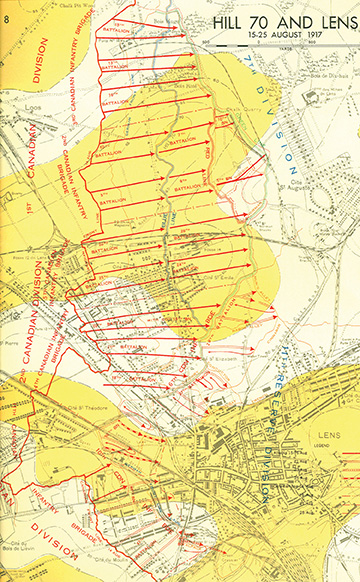
Map of Hill 70 and Lens.
Credit: Map from G.W.L. Nicholson, in C.E.F. 1914-1919 p. 296.
The Honour “Hill 70” was awarded to units that participated in the successful capture and defence of this prominent feature near Lens, France between 15 and 25 August 1917. At the beginning of July the Canadian Corps (Lieutenant-General Sir A.W. Currie) received orders to capture the city of Lens. Currie, the newly appointed Corps Commander, planned first to take the high feature of Hill 70 that dominated Lens from the north. The attack, originally planned for the end of July, was postponed due to weather until mid-August. This allowed the Canadian Corps to increase its preparations for the coming operation. As part of its preparations raids were conducted against German outposts and German artillery positions were destroyed as the Canadian gunners undertook a programme of wire-cutting, counter-battery and gas shelling. Engineers also prepared special drums of oil to be used on the morning of the attack to create a smoke screen. The infantry rehearsed their attack over similar terrain, but unlike previous attacks there was no large preparatory barrage which would have given the enemy warning of an impending operation. Surprise was achieved when the attack started at 4:25 on the morning of 15 August under cover of an immense artillery barrage. A simulated attack by the 4th Division (Major-General Sir D. Watson) in front of Lens served as a diversion for the 1st (Major-General Sir A.C. Macdonell) and 2nd (Major-General Sir H.E. Burstall) Divisions who successfully captured Hill 70. Having planned for the inevitable German counter-attacks these formations consolidated their gains rapidly and the artillery began its programme of shelling the known areas where the Germans would assemble for their counter-attacks. Over the next several days the Germans mounted at least 21 counterattacks against the Canadian defenders of Hill 70.
On 18 August, General Currie planned to improve the position in front of Lens on the southern edge of Hill 70. An attack by the 2nd and 4th Divisions supported by the grouping of the artillery from three Divisions plus the Corps Heavy artillery and guns of the Royal Canadian Horse Artillery was launched on 21 August. However, the Germans had anticipated the attack and even under the heavy barrage made the Canadian advance difficult. The attacks continued for the following days with little success and operations came to an end on 25 August. Even if the Canadians had not taken Lens, they had secured Hill 70 which dominated that city and it remained in Allied hands until the end of the war.
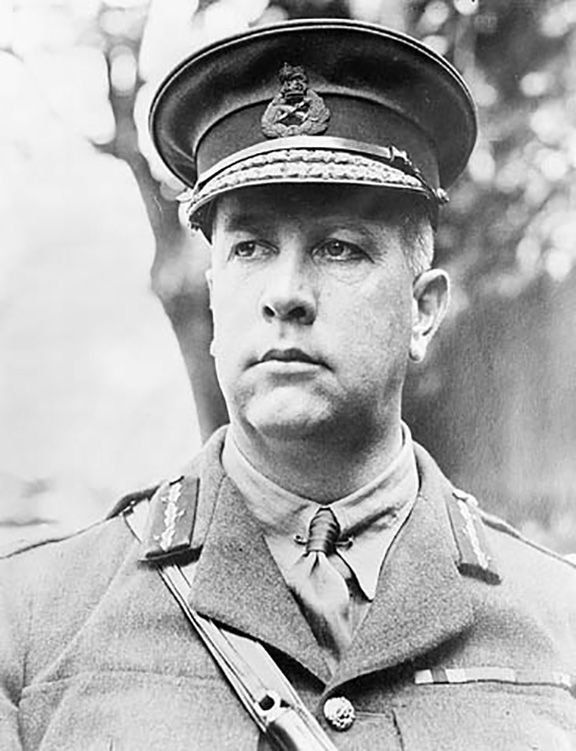
General Currie, Commander of the Canadian troops in France, and A.D.C. Location unknown. June, 1917.
Credit: Canada. Department of National Defence/Library and Archives Canada/PA-001370 (MIKAN no. 3191901)
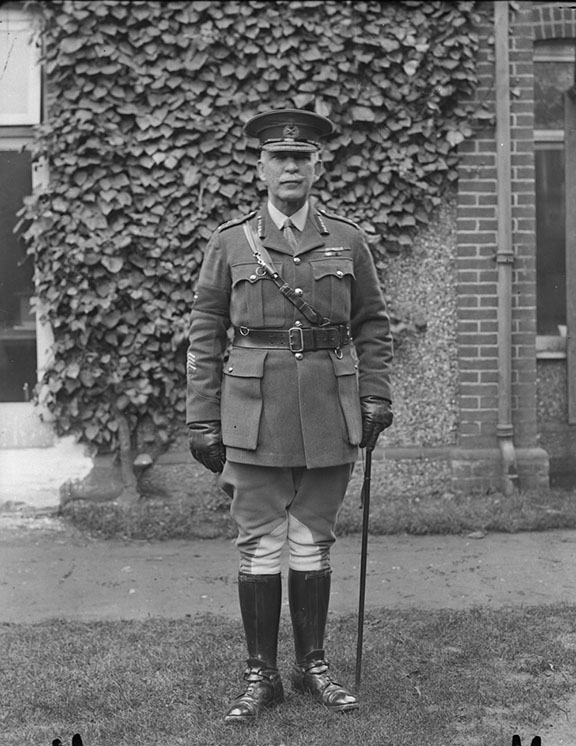
Major-General Sir Archibald Cameron Macdonell was the General Officer Commanding the 1st Canadian Division from June 1917 on. Location unknown. Date unknown.
Credit: Canada. Department of National Defence/Library and Archives Canada (MIKAN no. 3218799)
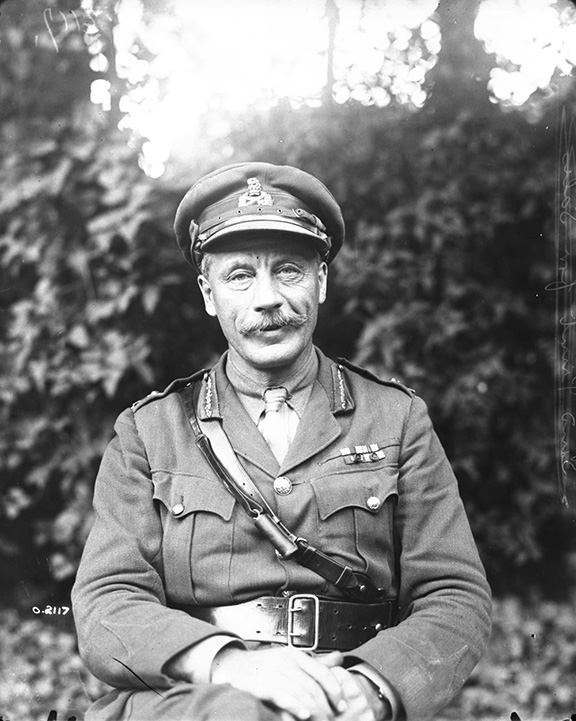
Major-General Watson, the Officer Commanding the 4th Canadian Division. Location unknown. October, 1917.
Credit: Canada. Department of National Defence/Library and Archives Canada (MIKAN no. 3222150)
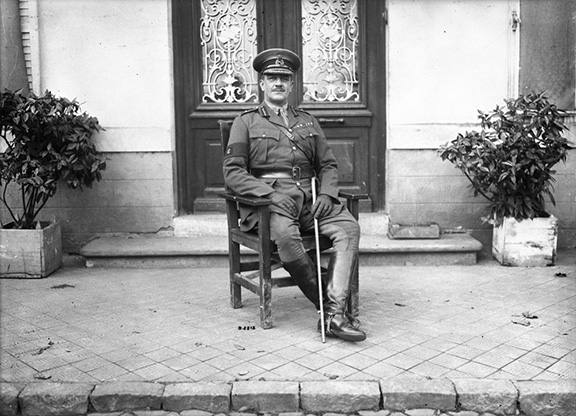
Major-General Sir Henry Edward Burstall was General Officer Commanding the 2nd Canadian Division. Location unknown. December, 1917.
Credit: Canada. Department of National Defence/Library and Archives Canada (MIKAN no. 3213482)
Awarded to:
Currently serving units
- 26th Field Artillery Regiment, RCA
Award to The Manitoba Rangers (GO 71/30) - 48th Highlanders of Canada
Awards to the 15th Canadian Infantry Battalion, CEF (GO 110/29) and The 48th Regiment (Highlanders) (GO 110/29) - 49th Field Artillery Regiment, RCA
Award to The Sault Ste. Marie Regiment (GO 71/30) - 56th Field Artillery Regiment, RCA
Awards to the 4th Canadian Infantry Battalion, CEF (GO 110/29), The Dufferin Rifles of Canada (GO 110/29), The Haldimand Rifles (GO 71/30), and The Norfolk Regiment of Canada (GO 71/30 - 64th Field Battery, RCA
Award to The Yorkton Regiment (GO 71/30) - 116th Independent Field Battery, RCA
Award to The Kenora Light Infantry (GO 71/30) - The Algonquin Regiment
Award to The Northern Pioneers (GO 71/30) - The Argyll and Sutherland Highlanders of Canada (Princess Louise's)
Awards to the 19th Canadian Infantry Battalion, CEF (GO 110/29) and The Argyll and Sutherland Highlanders of Canada (Princess Louise's) (GO 110/29) - The Black Watch (Royal Highland Regiment) of Canada
- Awards to the 13th Canadian Infantry Battalion, CEF (GO 110/29), the 42nd Canadian Infantry Battalion, CEF (GO 110/29), and The Royal Highlanders of Canada (GO 110/29)
- The British Columbia Dragoons
Awards to the 2nd Canadian Mounted Rifles Battalion, CEF (GO 110/29) and The British Columbia Dragoons (GO 110/29) - The British Columbia Regiment (Duke of Connaught's Own)
Awards to the 7th Canadian Infantry Battalion, CEF (GO 71/30), the 29th Canadian Infantry Battalion, CEF (GO 123/29), the 102nd Canadian Infantry Battalion, CEF (GO 110/29), the 1st British Columbia Regiment (Duke of Connaught's Own) (GO 110/29), The North British Columbia Regiment (GO 123/29), Irish Fusiliers of Canada (GO 71/30), and The Vancouver Regiment (GO 71/30) - The Calgary Highlanders
Awards to the 10th Canadian Infantry Battalion, CEF (GO 123/29) and The Calgary Highlanders (GO 110/29) - The Canadian Grenadier Guards
Awards to the 87th Canadian Infantry Battalion, CEF (GO 110/29) and The Canadian Grenadier Guards (GO 110/29) - The Canadian Scottish Regiment (Princess Mary's)
Awards to the 16th Canadian Infantry Battalion, CEF (GO 110/29) and The Canadian Scottish Regiment (GO 110/29). - The Essex and Kent Scottish
Awards to the 18th Canadian Infantry Battalion, CEF (GO 110/29) and The Essex Scottish (GO 110/29) - The Fort Garry Horse
Award to The Manitoba Horse (GO 144/31) - Les Fusiliers Mont-Royal
Award to Les Carabiniers Mont-Royal (GO 71/30) - Governor General's Foot Guards
Awards to the 2nd Canadian Infantry Battalion, CEF (GO 123/29) and The Governor General's Foot Guards (GO 71/30 and GO 32/32) - The Governor General's Horse Guards
Awards to the 4th Canadian Mounted Rifles Battalion, CEF (GO 110/29), The Governor General's Body Guard (GO 71/30 and GO 112/35) and The Mississauga Horse (GO 110/29) - The Grey and Simcoe Foresters
Award to The Grey Regiment (GO 71/30) and The Simcoe Foresters (GO 71/30) - The Halifax Rifles (RCAC)
Award to The Halifax Rifles (GO 71/30) - The Hastings and Prince Edward Regiment
Awards to The Hastings and Prince Edward Regiment (GO 71/30), The Argyll Light Infantry (GO 71/30) and The Northumberland Regiment (GO 71/30) - Irish Regiment of Canada
Award to Irish Regiment (GO 71/30) - The King's Own Calgary Regiment (RCAC)
Awards to the 50th Canadian Infantry Battalion, CEF (GO 110/29) and The Calgary Regiment (GO 110/29) - The Lake Superior Scottish Regiment
Awards to the 52nd Canadian Infantry Battalion, CEF (GO 123/29) and The Lake Superior Regiment (GO 110/29) - The Lincoln and Welland Regiment
Awards to The Lincoln Regiment (GO 71/30) and The Lincoln and Welland Regiment (GO 71/30) - The Lorne Scots (Peel, Dufferin and Halton Regiment)
Awards to The Halton Rifles (GO 71/30) and The Peel and Dufferin Regiment (GO 71/30) - The Loyal Edmonton Regiment (4th Battalion, Princess Patricia's Canadian Light Infantry)
Awards to the 49th Canadian Infantry Battalion, CEF (GO 110/29) and The Edmonton Regiment (GO 110/29) - The North Saskatchewan Regiment
Awards to the 1st Canadian Mounted Rifles Battalion, CEF (GO 110/29), the 5th Canadian Infantry Battalion, CEF (GO 110/29), The Saskatchewan Mounted Rifles (GO 110/29), The Saskatoon Light Infantry (GO 110/29), and The Prince Albert Volunteers (GO 71/30) - The North Shore (New Brunswick) Regiment
Award to The North Shore (New Brunswick) Regiment (GO 71/30) - The Nova Scotia Highlanders
Awards to the 25th Canadian Infantry Battalion, CEF (GO 123/29) and The Colchester and Hants Regiment (GO 110/29) - The Ontario Regiment (RCAC)
Awards to the 116th Canadian Infantry Battalion, CEF (GO 110/29) and The Ontario Regiment (GO 123/29) - The Princess Louise Fusiliers
Award to The Princess Louise Fusiliers (GO 71/30) - The Princess of Wales' Own Regiment
Awards to the 21st Canadian Infantry Battalion, CEF (GO 123/29) and The Princess of Wales' Own Regiment (GO 110/29) - Princess Patricia's Canadian Light Infantry
Award to Princess Patricia's Canadian Light Infantry (GO 123/29) - The Queen's Own Cameron Highlanders of Canada
Awards to the 43rd Canadian Infantry Battalion, CEF (GO 110/29) and The Queen's Own Cameron Highlanders of Canada (GO 110/29) - The Queen's Own Rifles of Canada
Awards to the 3rd Canadian Infantry Battalion, CEF (GO 123/29) and The Queen's Own Rifles of Canada (GO 110/29) - The Queen's York Rangers (1st American Regiment) (RCAC)
Awards to the 20th Canadian Infantry Battalion, CEF (GO 110/29), The Queen's Rangers, 1st American Regiment (GO 110/29) and The York Rangers (GO 71/30) - Le Régiment de Maisonneuve
Awarded through perpetuation of the 41st Canadian Infantry Battalion, CEF (CAO Part “A” 33-1 and 229-1 10 July 1961) - The Rocky Mountain Rangers
Award to The Rocky Mountain Rangers (GO 71/30) - Royal 22e Régiment
Award to the Royal 22e Régiment (GO 110/29) - The Royal Canadian Hussars (Montreal)
Awards to the 1st Canadian Motor Machine Gun Brigade, CEF (GO 110/29) and the 1st Motor Machine Gun Brigade (GO 110/29) - The Royal Canadian Regiment
Awards to the 1st Canadian Infantry Battalion, CEF (GO 110/29), The Royal Canadian Regiment (GO 110/29), The Canadian Fusiliers (City of London Regiment) (GO 110/29), and The Oxford Rifles (GO 71/30). - The Royal Hamilton Light Infantry (Wentworth Regiment)
Awards to the 4th Canadian Infantry Battalion, CEF (GO 110/29), The Royal Hamilton Light Infantry (GO 110/29), and The Wentworth Regiment (GO 71/30) - The Royal Highland Fusiliers of Canada
Award to The Highland Light Infantry of Canada (GO 71/30) - The Royal Montreal Regiment
Awards to the 14th Canadian Infantry Battalion, CEF (GO 110/29) and The Royal Montreal Regiment (GO 110/29) - The Royal New Brunswick Regiment
Awards to the 26th Canadian Infantry Battalion, CEF (GO 110/29), The Carleton Light Infantry (GO 110/29), The Saint John Fusiliers (GO 110/29), The York Regiment (GO 71/30) and The New Brunswick Rangers (GO 71/30) - The Royal Regiment of Canada
Awards to the 3rd Canadian Infantry Battalion, CEF (GO 123/29), the 58th Canadian Infantry Battalion, CEF (GO 110/29), the 123rd Canadian Pioneer Battalion, CEF (GO 123/29), the 124th Canadian Pioneer Battalion, CEF (GO 123/29), The Royal Grenadiers (GO 110/29), and The Toronto Regiment (GO 110/29) - The Royal Regina Rifles
Awards to the 28th Canadian Infantry Battalion, CEF (GO 110/29) and The Regina Rifle Regiment (GO 110/29) - The Royal Westminster Regiment
Awards to the 47th Canadian Infantry Battalion, CEF (GO 110/29) and The Westminster Regiment (GO 110/29) - The Royal Winnipeg Rifles
Awards to the 8th Canadian Infantry Battalion, CEF (GO 110/29), the 10th Canadian Infantry Battalion, CEF (GO 123/29), the 27th Canadian Infantry Battalion, CEF (GO 123/29), the 44th Canadian Infantry Battalion, CEF (GO 110/29), The Winnipeg Rifles (GO 110/29) and The Winnipeg Light Infantry (GO 110/29) - The Saskatchewan Dragoons
Awards to the 46th Canadian Infantry Battalion, CEF (GO 110/29) and The King's Own Rifles of Canada (GO 110/29). - The Sherbrooke Hussars
Awards to the 5th Canadian Mounted Rifles Battalion, CEF (GO 110/29), The Sherbrooke Regiment (GO 71/30), and the 7th/11th Hussars (GO 10/39) - The South Alberta Light Horse
Awards to the 31st Canadian Infantry Battalion, CEF (GO 110/29), The South Alberta Regiment (GO 110/29), The Edmonton Fusiliers (GO 71/30), and The South Alberta Horse (GO 88/31) - Stormont, Dundas and Glengarry Highlanders
Award to The Stormont, Dundas and Glengarry Highlanders (GO 71/30) - The Toronto Scottish Regiment (Queen Elizabeth The Queen Mother's Own)
Awards to the 75th Canadian Infantry Battalion, CEF (GO 110/29) and The Toronto Scottish Regiment (GO 110/29) - Les Voltigeurs de Québec
Award to Les Voltigeurs de Québec (GO 71/30) - The West Nova Scotia Regiment
Award to The Annapolis Regiment (GO 71/30)
Units on the Supplementary Order of Battle
- 1th Field Squadron, RCE
Award to The Lambton Regiment (GO 71/30) - 14th Canadian Hussars
Award to the 14th Canadian Light Horse (GO 5/31) - 24th Field Artillery Regiment, RCA
Awards to the 54th Canadian Infantry Battalion, CEF (GO 110/29) and The Kootenay Regiment (GO 110/29) - 26th Field Battery, RCA
Award to The Lambton Regiment (GO 71/30) - 27th Field Artillery Regiment, RCA
Award to The Eastern Townships Mounted Rifles (GO 110/29) - 33rd Medium Artillery Regiment, RCA
Award to The Frontenac Regiment (GO 71/30) - 48th Field Squadron, RCE
Award to The Lambton Regiment (GO 71/30). - 50th Field Artillery Regiment (The Prince of Wales' Rangers), RCA
Awards to the 2nd Canadian Infantry Battalion, CEF (GO 123/29), The Peterborough Rangers (GO 110/29), and The Victoria and Haliburton Regiment (GO 71/30) - 118th Medium Battery, RCA
Awards to the 1st Canadian Mounted Rifles Battalion, CEF (GO 110/29) and The Manitoba Mounted Rifles (GO 5/31) - 202nd Field Battery, RCA
Award to The Yorkton Regiment (GO 71/30) - The Royal Rifles of Canada
Award to The Royal Rifles of Canada (GO 71/30) - The South Saskatchewan Regiment
Awards to The Weyburn Regiment (GO 71/30) and The Saskatchewan Border Regiment (GO 71/30) - Victoria Rifles of Canada
Awards to the 24th Canadian Infantry Battalion, CEF (GO 110/29) and The Victoria Rifles of Canada (GO 110/29) - The Winnipeg Grenadiers
Award to The Winnipeg Grenadiers (GO 110/29)
Disbanded Units
- 2nd Canadian Pioneer Battalion, CEF
Award to the 2nd Canadian Pioneer Battalion, CEF (GO 123/29) - 16th/17th (Reserve) Medium Battery, RCA
Award to The Kenora Light Infantry (GO 71/30) - 107th Canadian Pioneer Battalion, CEF
Award to the 107th Canadian Pioneer Battalion, CEF (GO 123/29) - The Irish Canadian Rangers
Award to The Irish Canadian Rangers (GO 71/30) - The Manitoba Regiment
Award to The Manitoba Regiment (GO 123/29) - McGill University Contingent (148th Bn., C.E.F.), The Canadian Officers' Training Corps
Award to the McGill University Contingent (148th Bn., C.E.F.), The Canadian Officers' Training Corps (GO 136/32) - The Middlesex and Huron Regiment
Award to The Middlesex Light Infantry (GO 71/30) - The North Alberta Regiment
Awards to the 31st Canadian Infantry Battalion, CEF (GO 110/29) and The North Alberta Regiment (GO 110/29)
Page details
- Date modified: